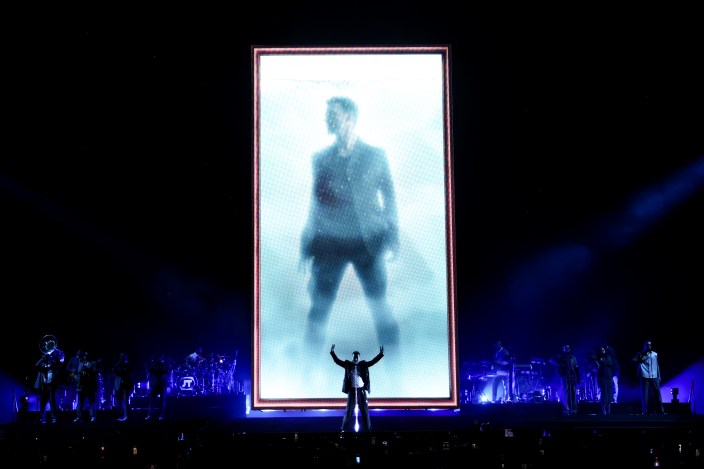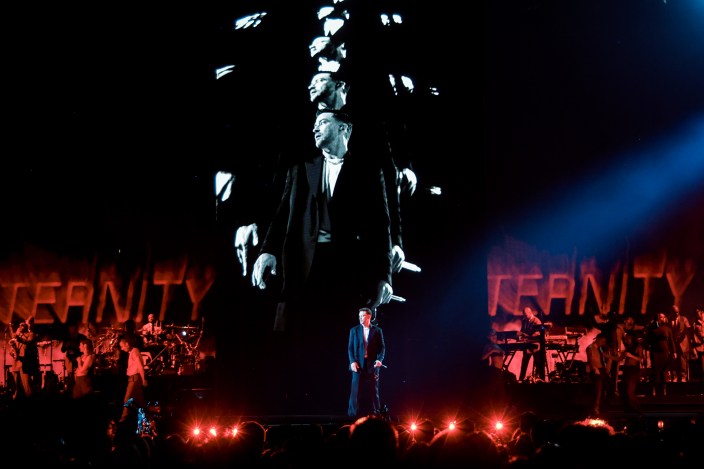It’s been said that monoculture is dead, but even as we are overwhelmed with microniches and hyperfocused marketing beamed directly into our faces by our ever-growing multitude of screens, there are still some people, some moments, that can bring us together as monoliths of pop culture.
No one defines the turn-of-the-millennium pop culture where monoliths still loomed large like Justin Timberlake, who is currently on the Forget Tomorrow world tour promoting his new album, Everything I Thought It Was. And when he needed a visual representation of his imposing legacy, he turned to Silent House Group, the production house that specializes in massive scale arena and festival concert production.
After previously detailing their work for Coachella headliners Tyler The Creator and Doja Cat, Uproxx interviewed Silent House CEO and Founder, Baz Halpin, about how the gigantic, yet stripped-down production for Timberlake’s tour came together. From cutting-edge tech out of a sci-fi film to happy accidents to the future of touring, the conversation was as expansive as Timberlake’s generation defining catalog.

Can you break down for me how you started the process and how close did the finished product come to the idea in progress?
Justin is incredibly knowledgeable as a director in his own right, I think, because of his work in film and theater and everything else. He’s way more hands-on and I wasn’t expecting that. So the first place he wanted to start was, before we get into the narrative and the why, he wanted to get up to speed with absolutely everything that you could do in 2024 with live production.
I was sitting in his living room saying, “Everything?” He goes, “I want you to go away and I want you to come back to me and show me everything that you can do in 2024. Show me what all the new tech is. Show me all the great ideas. Let’s push it. Let’s do something that’s never been done before.” So I went away and I put everything. I put 150 pages together in a document, videos, images, you name it. Everything from the lights that hadn’t even been manufactured yet, prototypes that we found some guy making in his garage, and video screens that you could put in a swimming pool or would roll out like a piece of rubber.
Oh, that’s cool.
And so we batted this around for a long time, and then we came up with this idea: Well, really, this wants to be a lot of things. This show wants to be a lot of things, but at the same time, it has to be a vehicle to showcase his unbelievable talent. There’s very few 360 entertainers like him that can sing, dance, play, entertain at that high level, and he’s the real deal.
So I wanted to be able to have this enormous stage with absolutely nothing on it. No equipment, no people, no nothing. You couldn’t see anything on it, and just have him in a spotlight, and for him to showcase that he was able to command this arena with 20,000 people in with absolutely nothing. To go from that to the most high-tech bells and whistles, the biggest thing you ever saw in your life. So we came up with this idea of the monolith and the monolith being a vehicle that would take us on this journey.
So we started from this tech place, engineering place. What’s possible moved into, how, visually, do we want to break down the show? Then, the third place was, well, we have this idea of a monolith could be a vehicle and could do all these things and could bring us from nothing to everything. We could give it a personality. We could give it its own theme that carried it through the show. So once we had that in our head as the direction we wanted to go, then we started to work on the set list. That’s when the narrative started to get put in.

Would it be giving away secrets if you told me what were some of the names that he name-checked, as far as inspirations for the show?
Obviously, [David] Fincher, who he talks a lot about… We reference the work of Denis Villeneuve, because stylistically, visually, that’s… These are very different, right? Very different visual approaches. I mean, he’s a cinephile for sure and a movie buff. When you can talk in the language, and you understand the tech, and you understand visual storytelling, then you can have really clear conversations.
So with him, because he is so hands-on, it made that process much, much clearer and like a director, when he makes a decision, he makes a decision from a place of information. He’s informed. So it took a lot of the scary sort of stress of, do we know what we’re getting ourselves in for? The process, it was structured. It was foundational. It left all the time for you to be creative, but understanding the world that you were living in.
Obviously, when you’re on the cutting edge, things do not work the way they’re supposed to or the way that you thought that they might. Were any of those challenges something that you even incorporated? I know sometimes, let’s say, the light turns blue, and it’s supposed to turn green, but then you’re like, oh, that actually looks cooler.
The happy accident on this was when the monolith tips over, and he leans off the edge.
So I had put a winch and I don’t know what it was. I knew that I wanted to have a performer-flying winch, and I sort of had these ideas. Maybe I’d have a dancer on it, and the dancer would be dancing on the video screen vertically and interact with it or something like that. When we got into rehearsals, we hadn’t sort of finalized how the show would end. So finding that moment with Justin in the performer-flying winch when it tipped over, and we saw that for the first time, we went, “Holy sh*t.” That is it. We didn’t think about that until rehearsals.
With your expertise and having worked with some of the best, where do you see the live touring space, and especially the Silent House aspect of it, what you guys do, where do you see that going in the near future?
I mean, I think there will be new types of places for sure, but concerts are in an increasingly isolated world where we’re all buried in computers and phones and work from home and all that stuff. And we do not have the community as humans that we had 30 years ago. These concerts, festivals, shows, those are… It’s concerts, live events and sporting events. I don’t think there’s anything else that brings people together in a community the way those things do, right? For better or worse.
And I think that it’s a fundamental human need to experience things as a community. So I think that no matter what happens in the world, that live music will keep getting more and more and more important. I think that artists will continue to push all the boundaries that they can, both creatively and logistically. And people want to go see these shows. There’s a hunger. Even in 2008, 2009 when we had the recession, the concert industry went from strength to strength. It’s where people go. It’s where people go when they’re happiest. It’s where people go when they’re bummed out. And music especially hits us in a way that is fundamental, and it can transport us back in time, and it can take us to places and spark memories that we’ve forgotten, so I don’t think you can phase that out. I don’t think it goes away. And as long as that need is there and that demand is there from audiences, and they want to go see, and artists want to create, then Silent House will always be there to support them.







